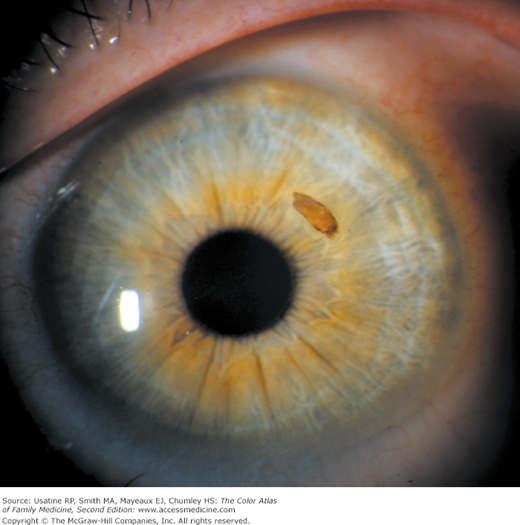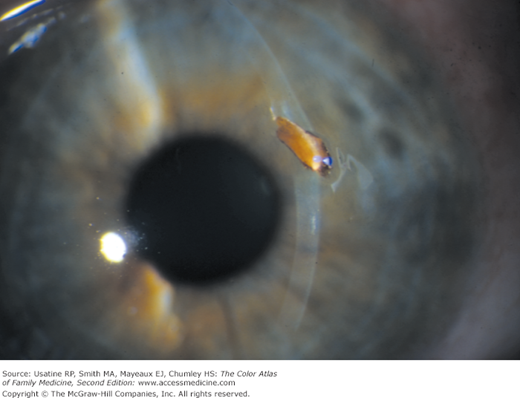Patient Story
A 28-year-old man felt something fly into his eye while he was using a table saw without wearing protective eye gear. He presented with pain, tearing, photophobia, and thought that something was still in his eye. On examination with a slit lamp, the physician noted that he had a wood chip that had penetrated the cornea (Figures 15-1 and 15-2). He was referred to an ophthalmologist who successfully removed the foreign body. He was treated with a short course of topical NSAIDs for pain relief, and had complete healing.
Introduction
Corneal abrasions are often caused by eye trauma and can cause an inflammatory response. Corneal abrasions are detected using fluorescein and a UV light. A corneal foreign body can be seen during a careful physical examination with a good light source or slit lamp. Nonpenetrating foreign bodies can be removed by an experienced physician in the office using topical anesthesia. Refer all penetrating foreign bodies to an ophthalmologist.
Epidemiology
- Corneal abrasions with or without foreign bodies are common; however, the prevalence or incidence of corneal abrasions in the general population is unknown.
- Corneal abrasions accounted for 85% of closed-eye injuries in adults presenting to an emergency department.1
Etiology and Pathophysiology
- The cornea overlies the iris and provides barrier protection, filters UV light, and refracts light onto the retina.
- Abrasions in the cornea are typically caused by direct injury from a foreign body, resulting in an inflammatory reaction.
- The inflammatory reaction causes the symptoms and can persist for several days after the foreign object is out.
Risk Factors
- Those with occupations such as metal workers, woodworkers, miners, and landscapers have an increased risk of corneal injuries from foreign bodies.2
- Participating in sports such as hockey, lacrosse, or racquetball raises the risk of corneal abrasions from ocular trauma.2
- Ventilated neonates (as a result of mask pressure on the orbit) or sedated patients (as a result of disruption of the blink reflex, and subsequent corneal exposure) are at increased risk for corneal abrasions.2
Contact lenses, especially soft extended wear, increase the risk of developing an infected abrasion that ulcerates.2
Diagnosis
History and physical
Stay updated, free articles. Join our Telegram channel

Full access? Get Clinical Tree




